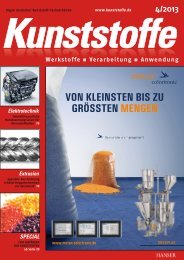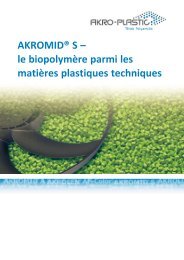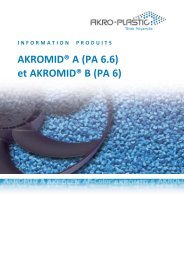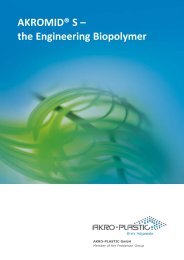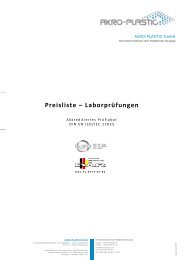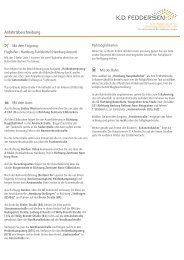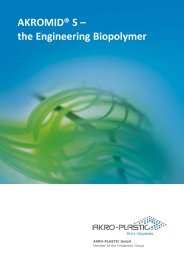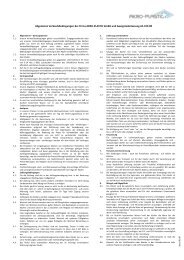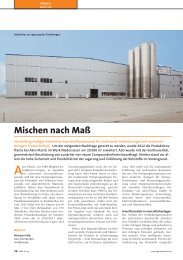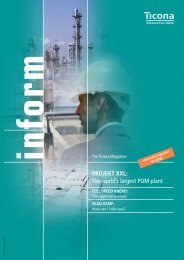AKROMID® RM brochure A3 - AKRO-PLASTIC GmbH
AKROMID® RM brochure A3 - AKRO-PLASTIC GmbH
AKROMID® RM brochure A3 - AKRO-PLASTIC GmbH
- No tags were found...
You also want an ePaper? Increase the reach of your titles
YUMPU automatically turns print PDFs into web optimized ePapers that Google loves.
Product characterisation <strong>AKRO</strong>MID® <strong>RM</strong>-D DesignB3 S3 natural (3438)B3 2 <strong>RM</strong>-D black (3254)B3 2 <strong>RM</strong>-D black (3255)B3 1 black (2501)Moisture absorptionas a function of exposure time (Fig. 1)3.5Heat ageing –yield stress vs. exposure time @ 125 °C (Fig. 4)80B3 3 S3 10 blackB3 2 <strong>RM</strong>-D black (3254)B3 2 <strong>RM</strong>-D black (3255)Ageing conditions:Temperature: 70 °CRel. humidity: 62 %Ageing period: 500 h<strong>AKRO</strong>MID® <strong>RM</strong>-D (design grades) isparticularly well-suited for visibleparts or insert-moulded trim elements,such as interior parts in theautomotive sector where low warpageand small clearances aftermoisture absorption are required.Also, sanitary applications aresuitable, where minimal loss of stiffnessand high strength at extremelyhigh moisture contents is required.This product line provides an impressiveproperty profile and isavailable in non-reinforced compoundsas well as reinforced compoundswith extremely high notchedimpact strength and low warpagetendency.Available with UV-stabilised, impact-resistantor high-impact surfacetreatments, the non-reinforcedgrades excel due to their excellentsurface quality. The reinforcedgrades are also characterised bygood surface quality and optimisedprocessing behaviour.The <strong>AKRO</strong>MID® <strong>RM</strong>-D series exhibitsan improvement of 50 % inmoisture uptake compared to standardPA6 – see Fig. 1. This leads tosignificantly improved dimensionalstability compared with standardPA6. The characteristic good processingbehaviour of PA6 is comparable.Moisture absorption [%]Tensile modulusas a function of exposure time (Fig. 2)Tensile modulus [MPa]Yield stress [MPa]3.02.52.01.51.00.50.00 50 100 150 200 250 300 350 400 450 5004,0003,0002,0001,000Exposure time [h]0 50 100 150 200 250 300 350 400 450 500Exposure time [h]Yield stressas a function of exposure time (Fig. 3)9075604530150 50 100 150 200 250 300 350 400 450 500Exposure time [h]Yield stress [MPa]6040200 50 100 150 200 250 300 350 400 450 500Typical values forblack colored products at 23 °C B3 2 <strong>RM</strong>-D (3254) B3 (2500) B3 3 S3 10Mechanical Properties d.a.m. conditioned d.a.m. conditioned d.a.m. conditionedDensity 1,1 1,13 1,1Charpy notched impact strength RT 15 17 3 12 10 28Tensile modulus 2.500 1.500 3.600 1.200 2.700 955The tensile modulus of the <strong>AKRO</strong>-MID® series decreases less thanstandard PA types. <strong>AKRO</strong>MID ® B3 2<strong>RM</strong>-D Black (3255) has a lower stiffnesscompared to standard PA6 dryas moulded, but after conditioningthe stiffness is at the same level as<strong>AKRO</strong>MID® B3 1 black (2501) andconsiderably higher than the impactmodified version <strong>AKRO</strong>MID® B3 S3(3438) – see Fig. 2.The yield stress shows a similar behaviour,decreasing far less with<strong>AKRO</strong>MID® <strong>RM</strong>-D grades comparedto standard PA6 at elevated exposuretime. Therefore, the stiffnessof <strong>AKRO</strong>MID® B3 S3 natural (3438)after conditioning, is significantlylower when considering a higher valuein the dry as moulded condition.This very consistent behaviour is anessential added value for applicationdesign – see Fig. 3.Exposure time [h]The <strong>AKRO</strong>MID® <strong>RM</strong>-D grades arecharacterised by excellent heatageing resistance. The tensilestrength shows only slight variationover 500 hours at 125 °C – higherthan that of the standard productafter ageing. The standard gradedemonstrates greater strengthwhen dry as moulded – see Fig. 4.Of particular importance is the approximate5 % lower density of<strong>AKRO</strong>MID® <strong>RM</strong>-D compared withconventional PA6, which can beused to achieve a weight advantagefor the component – see table.<strong>AKRO</strong>MID® <strong>RM</strong>-D also has betteracoustic behaviour and superiordamping properties compared withmaterials such as ABS, PC + ABS,etc. However, the achievable surfacefinish is dull compared to thatof ABS.8 9




